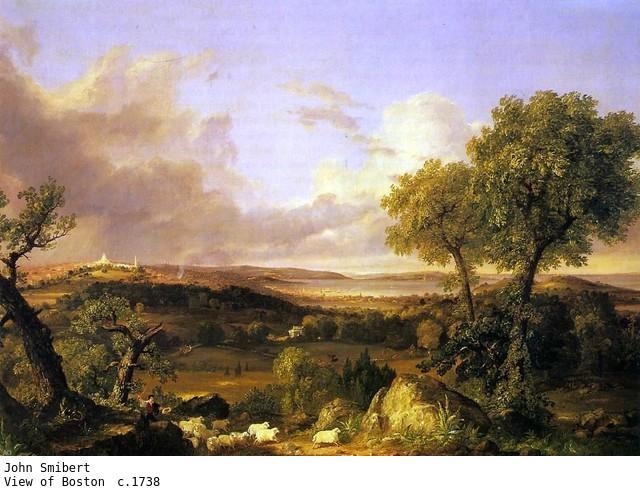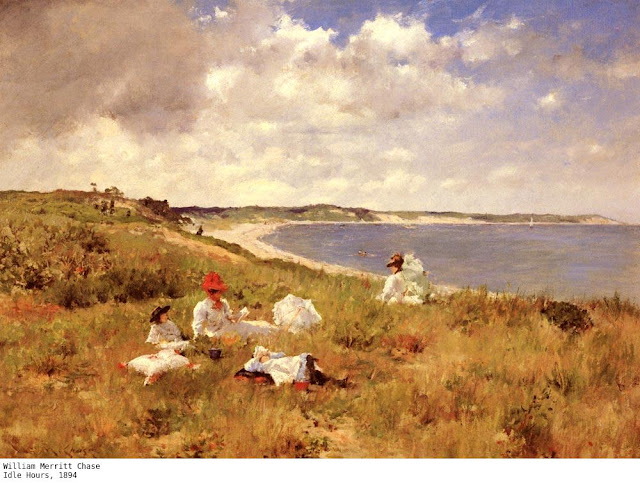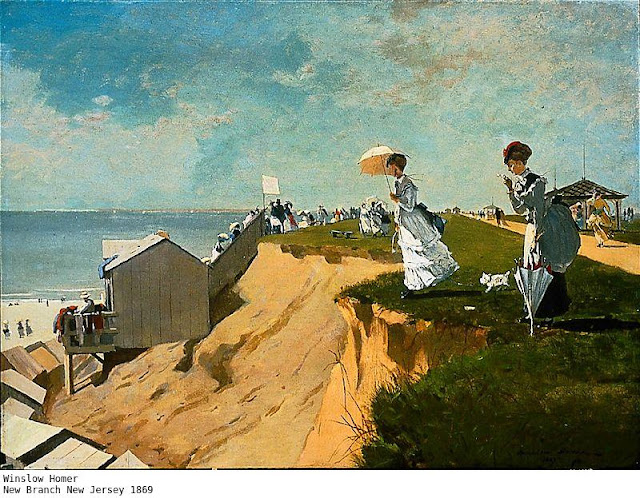The art of North America has several periods:
Colonial Art to 1776
In the 18th and later centuries there were American versions of the movements in European art in the 19th Century, often with a 10 or 20 year delay. The following are all represented:
Neo-Classical,
Romantic,
Pre-Raphaelite,
Naturalist,
Realist,
Impressionist
The American credentials of the artists were justifiably highlighted by prefixing the word “American” because they often took the movements in a distinctly American direction.
American Colonial Art
It is unfortunate that many paintings produced in North America during the 16th to 19th centuries have been lost. The Americans had a cavalier attitude to their past and even as late as 1979 I remember seeing a street in Philadelphia preserved as the “oldest city street” whilst wrecking balls were destroying nearby buildings of apparently identical age and architectural merit.
“Interestingly enough, the first account of an American landscape painter comes from Puritan Boston in 1740 when the New England Journal announced the death of the thirty-six-year-old Nathaniel Emmons. "He was universally own'd to be the greatest master of various Sorts of Painting that ever was born in this Country. And his excellent Works were the pure Effect of his own Genius, without receiving any Instructions from others." The obituary goes on to mention his "Rivers, Banks and Rural Scenes," none of which, apparently, have survived.” (AL Cummings)
The artists of this period were chiefly involved in documenting events, places and people. This gives them a considerable charm that derives from their historical interest. The artists are sometimes called “Limners”, a term for early American untutored artists, and the names of these artists are often lost.
Although the artist is unknown there are records of “Mrs Freake. Elizabeth Freake was born May 22, 1642, the daughter of Thomas (d. 1682/3) and Mary Clarke, in Dorchester, south of Boston. On May 28, 1661, Elizabeth Clarke married John Freake (1631–1675) in Boston. John emigrated about 1658 from England and was a successful merchant and attorney who held public office as a juryman and a constable. The Freakes settled in Boston's North End, and between 1662 and 1674 Elizabeth gave birth to eight children.7 John Freake died in an accident in 1675, leaving Elizabeth a substantial fortune. “ http://www.worcesterart.org/collection/Early_American/Artists/unidentified_17th/elizabeth_f/painting-discussion.html
Colonial era artists
Captain Thomas Smith (1650-1700)
John Singleton Copley
Robert Feke (1707-1752)
John Smibert (1688-1751)
Gilbert Stuart
Charles Bridges (1670-1747)
Benjamin West
The self portrait by Captain Thomas Smith 1680 (below) is the earliest known American self portrait.

The consulting Curator of American Art, Dallas Museum of Art, Eleanor Jones Harvey, described some of these early artists:
"John Smibert was the first professionally trained portraitist in the American colonies. He came to the colonies in 1728 and immediately established the new standard for colonial portraiture.
Copley was the natural inheritor of that tradition. He was essentially self-taught, yet he exceeded all expectations of his ability to portray the people of his place and time. Gilbert Stuart raises questions about the nature of patriotism when the sitter is made to resemble the President and First Lady of the new United States,"
Post Independence Art
In Canada and the USA artists tended to follow the European fashions, in the USA the Neoclassical style was appropriate to depict the new leaders.
William S. Jewett
Edward Savage (1761–1817)
James Peale (1749-1831)
Benjamin West
Martin Johnson Heade
Benjamin West 1738-1820
Benjamin West was one of the most accomplished colonial era artists. In the painting “General Johnson” he uses the techniques of the Rococco style, having recently spent 3 years in Itay. The painting depicts an incident in the North American theatre of the Seven Years War in which the British General Johnson saves the wounded French officer Baron Dieskau from being scalped by a Mohawk (The Mohawks were allies of the British).
Later Benjamin West tried his hand at the neoclassical style:
American Pre-Raphaelites
In Britain the Pre-Raphaelites started in 1848 and were a movement that extended through most of the nineteenth century. The American Pre-Raphaelites took to heart the teachings of Ruskin. They were led by Thomas Charles Farrer and in 1863 founded the "Association for the Advancement of Truth in Art" which published "The New Path". The members were: John William Hill, his son, John Henry Hill, Charles Herbert Moore, Henry Roderick Newman, Robert J. Pattison and William Trost Richards. The movement petered out in about 1870. The American Pre-Raphaelites were focussed on portraying nature as perfectly as possible and were less interested in mythological and religious themes than the Europeans.
Pre-Raphaelites were symbolists and according to Victorian symbolism Hill's painting is very straightforward: the dog rose means pleasure and pain, the red currant symbolises life or blood, the egg birth or even creation.
American Naturalism
Naturalism in the visual arts is the desire to represent nature in as accurate and detailed fashion as possible. There was a strong naturalist tradition in England in the late eighteenth and early nineteenth century represented by the English Landscape School and culminating in the work of John Constable. This naturalist style was a major influence in Europe and was known in the USA. It gave rise to the Barbizon style in France. However, the extent to which it influenced American Naturalism, beyond the idea of a faithful reproduction of nature, is in doubt.
The high point of American Naturalist painting in the nineteenth century was the Hudson River School. This was founded by Thomas Cole.
The Hudson River School
Thomas Cole (1801 – 1848)
Thomas Cole moved from England to the USA in 1818 and pursued portrait painting, studying with an artist called Stein. His real interest lay with landscape painting and in 1824 he moved to Philadelphia where he spent a short time at the Pennsylvania Academy of the Fine Arts which had been founded in 1805. He moved to New York in 1825 where he helped to found the National Academy of Design which subsequently became known as the “National Academy”.
The Hudson River School grew around Cole's love of the American landscape, he was joined by his close friend Asher Durand and had a gifted pupil Frederic Edwin Church. This trio formed the nucleus of the Hudson River School which grew with the addition of Durand's friends John Frederick Kensett and John William Casilear and then expanded as many other artists joined them. A notable member was Albert Bierstadt who later became an important artist in the “Rocky Mountain School”, or group of artists, who painted the landscape of the American West.
American Luminism
Luminism was a style of painting in which the brush strokes are carefully hidden, giving a more photographic realism to paintings. It was a style that was popularised by the seventeenth century Leiden Fine Artists, especially Gerrit Dou, and may have been learnt by Durand and his friends in a tour of Europe. It became, to some extent, a hallmark of the Hudson River School and is known as American Luminism in this context.
Niagara Falls by Frederick Edwin Church (1857) is a good example of both the Naturalism and Luminism of the Hudson River School
American Impressionism
Impressionism had begun in France in about 1863-65. The American artist, Mary Cassatt was central to the development of Impressionism owing to her wealthy connections in Philadelphia (and superb paintings) but she was central to European Impressionism, not American. James Whistler and John Singer Sergeant were successful American masters who skilfully incorporated the Impressionist style in their art but again they were deeply involved in Europe. It was probably the Impressionist exhibitions in New York and other major American Cities from the 1880s onwards and the visits of American artists to France in the late nineteenth century that stimulated a truly American Impressionist movement.
American Impressionists were notable for working in artistic colonies at places such as at Cos Cob and Old Lyme, Connecticut, both on Long Island Sound; New Hope, Pennsylvania, on the Delaware River; and Brown County, Indiana,in California at Carmel and Laguna Beach; in New York on eastern Long Island at Shinnecock.
There is something languid and upper class about American Impressionism and this repelled the artists who became the later American Realists.
There were numerous American Impressionists, here is a list of some of the more notable:
William Merritt Chase, Edmund Tarbell, Frank W. Benson, Childe Hassam, Joseph Rodefer De Camp, William James Glackens, Willard Leroy Metcalf, Ernest Lawson, Robert Spencer, Robert Vonnoh.
American Realism
American Realism was a movement in the arts that was devoted to portraying the lives of ordinary people and portraying ordinary places. It was a continuation of much of earlier American art which had always eschewed the mythological or allegorical, perhaps because the varied origins of Americans meant that there were few common themes and because Protestants were not fond of religious art. American Realists emphasized the ordinary rather than the wealthy or special. Nineteenth century American artists often found employment as illustrators with the large number of magazines and newspapers that were popular at that time and this also predisposed them to Realism.
Winslow Homer (1836-1910)
Winslow Homer was probably the most accomplished artist of the mid-late 19th Century USA. He received his art education at the National Academy of Design. His style is fairly unique, being a synthesis of many of the styles present in around 1860.
He spent 20 years of his working life as a freelance illustrator submitting illustrations to publications such as “Harper's Weekly”. Harpers sent him to the front to cover the American Civil War.
In December 1866 he went to France for a year and studied French Realists such as Courbet and Millet.
Later American Realism
In the late 19th century there was a realist reaction to the art of the wealthy that was dominating American Impressionism.
The Ashcan School
These artists rejected American Impressionism and believed in urban realism. Some of the artists worked to a socialist ideal. They originally consisted of the "Philadelphia Five": Robert Henri, George Luks, William Glackens, John Sloan, and Everett Shinn. All except Henri were illustrators and trained by Henri at the Pennsylvania Academy of Fine Arts in Philadelphia. The five migrated to New York from 1896 onwards.
The group expanded rapidly to include artists such as George Bellows, Glenn O. Coleman, Jerome Myers, Gifford Beal, Eugene Higgins, Carl Springchorn, and Edward Hopper although Edward Hopper is often thought to have worked outside of the ideals of the Ashcan School.
(The “Eight” were a group who exhibited together occasionally: the Philadelphia 5 plus Arthur B. Davies, Ernest Lawson, and Maurice Prendergast. Davies was post-impressionist and later cubist, Prendergast was post-impressionist and Lawson was impressionist.)
THE BEGINNINGS OF AMERICAN LANDSCAPE PAINTING BY ABBOTT LOWELL CUMMINGS
Assistant, Department of American Art http://www.metmuseum.org/pubs/bulletins/1/pdf/3258297.pdf.bannered.pdf




























